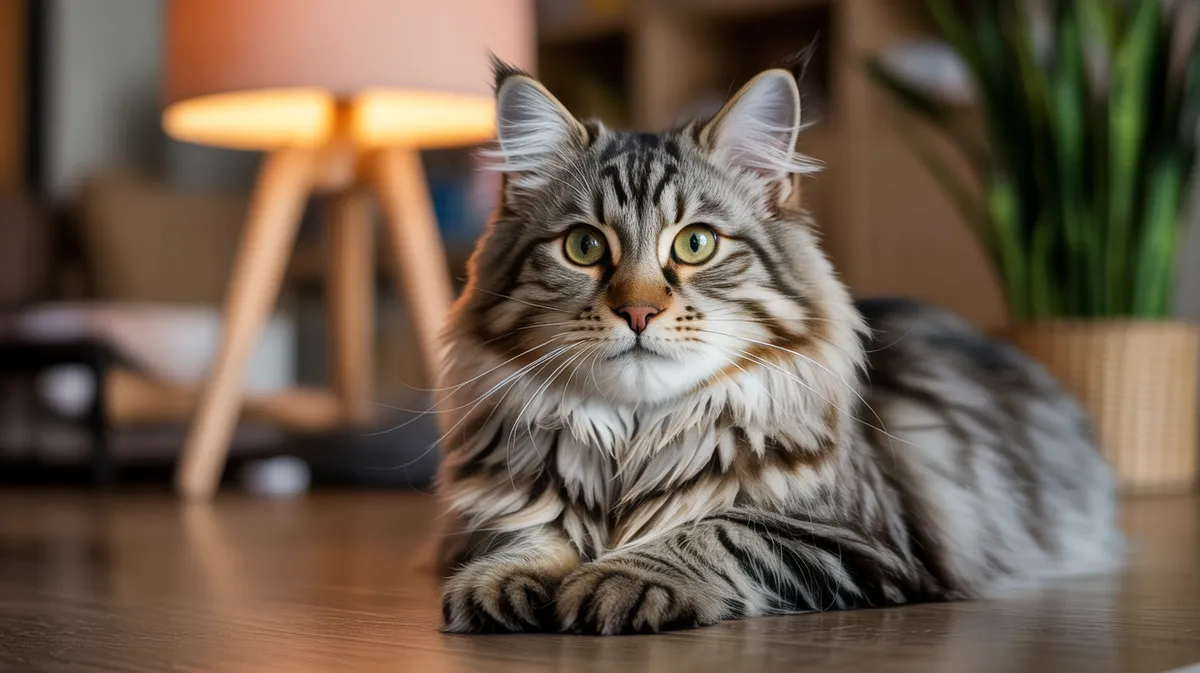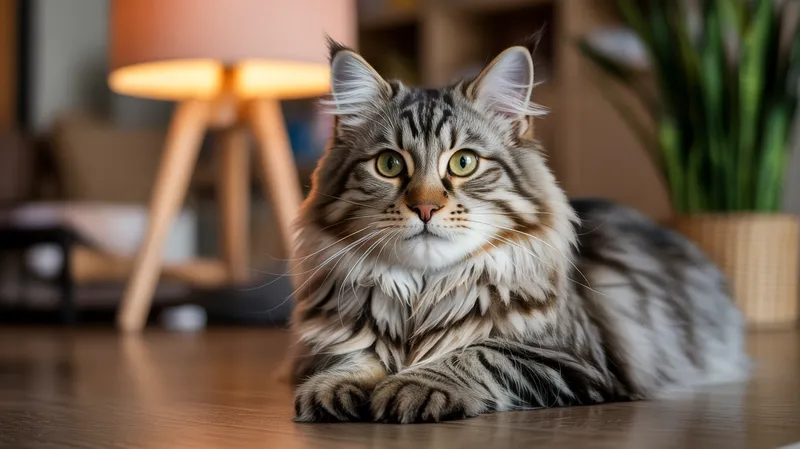
German Longhair
Felis catus

Meet the German Longhair
The German Longhair is a rare, elegant domestic cat breed originating in Germany, known for its luxurious semi-long coat and balanced physique. Developed in the early 20th century, it was bred to combine the long fur of Persian cats with the robustness and health of native European cats. This breed is admired for its gentle temperament, intelligence, and adaptability, making it a delightful companion. The German Longhair has expressive eyes, a broad head, and a dense, silky coat that requires regular grooming.
Classification
Mammal
Habitat
Domestic (human homes and urban environments)
Diet
Carnivore
Lifespan
12-16 years
Conservation
Least Concern
Weight
4-7 kg
📖Fascinating Facts
Revived Rarity
The German Longhair breed nearly vanished but was brought back from near extinction by passionate breeders in Germany.
Genetic Diversity
The breed was developed to maintain the health and vigor of native European cats while incorporating the luxurious coat of the Persian.
Low Maintenance Coat
Despite their long fur, German Longhairs have a silky, non-matting coat that is easier to groom than many other long-haired breeds.
📋Detailed Description
The German Longhair is a medium-to-large domestic cat breed, typically weighing between 4.5 and 7 kg, with males generally larger than females. Its most distinguishing feature is a dense, semi-long, water-repellent coat that is silky to the touch and comes in a wide variety of colors and patterns, often with a pronounced ruff around the neck and bushy tail. The breed exhibits a broad, slightly rounded head, medium-sized ears with tufted tips, and large, expressive, almond-shaped eyes that can range from green to copper hues. Muscular yet graceful, the German Longhair has a balanced physique, with strong limbs and a sturdy bone structure, reflecting its mixed heritage of Persian and robust European cats. Behaviorally, it is known for its calm, affectionate temperament, displaying high intelligence and a playful curiosity well into adulthood. The breed is highly adaptable, thriving in both quiet and active households, and is noted for forming strong social bonds with humans and other pets. Its vocalizations are typically soft and infrequent, relying more on body language for communication. The German Longhair is also recognized for its longevity and general good health, owing to selective breeding practices that prioritize genetic diversity. Regular grooming is essential to prevent matting and maintain coat health, but the breed's coat is less prone to tangling compared to other longhaired breeds. Overall, the German Longhair combines aesthetic elegance with a robust constitution and a gentle, companionable nature.
💡 Did you know?
Despite its origins in the early 1900s, the German Longhair was only officially recognized as a distinct breed in the 21st century.
🔬Research & Sources
🎭Behavior & Social Structure
German Longhairs are sociable and interactive, often seeking the company of their human family members and displaying a strong preference for being involved in household activities. They are moderately active, enjoying interactive play sessions, puzzle toys, and gentle climbing, but are not as hyperactive as some other breeds. Their hunting instincts remain intact, and they may exhibit stalking and pouncing behaviors with toys or, if allowed outdoors, small prey. Feeding behavior is typical of domestic cats, with a preference for multiple small meals throughout the day, and they may show food-oriented problem-solving skills. Socially, German Longhairs are tolerant of other cats and dogs, provided proper introductions are made, and they often establish hierarchical but peaceful relationships with other pets. They are known for their gentle approach to children and their ability to adjust to changes in routine, making them suitable for diverse family settings. Daily routines include periods of active play interspersed with long rest periods, often in elevated or secluded spots. Grooming behaviors are pronounced, with self-grooming supplemented by mutual grooming in multi-cat households, reinforcing social bonds.
👶Reproduction & Life Cycle
German Longhairs reach sexual maturity between 6 and 12 months of age. Breeding typically occurs year-round in indoor environments but may be more seasonal in regions with pronounced daylight variation, peaking in spring and summer. The female exhibits a polyestrous cycle, coming into heat every 2–3 weeks if not bred. Mating involves courtship behaviors such as vocalizations, rolling, and scent marking. Gestation lasts approximately 63–67 days, after which the queen gives birth to litters averaging 3–5 kittens. Parental care is primarily provided by the mother, who nurses and grooms the kittens, teaching them social and hunting skills as they grow. Kittens are weaned at 8–10 weeks and reach full independence by 12–14 weeks. Responsible breeders emphasize genetic health screening and avoid inbreeding to maintain the breed’s robust constitution.
🛡️Adaptations & Survival
The German Longhair's semi-long, water-repellent coat provides insulation against cold and damp conditions, a trait inherited from its European ancestors adapted to temperate climates. The dense undercoat and longer guard hairs help regulate body temperature and protect the skin from minor injuries. Their strong, muscular build and agile limbs facilitate climbing and jumping, while retractable claws and sensitive vibrissae (whiskers) enhance their ability to navigate complex environments. Behaviorally, their intelligence and adaptability allow them to thrive in a variety of domestic settings, and their social flexibility enables harmonious integration into multi-pet households. The breed’s relatively low-maintenance coat, compared to other longhaired cats, is an evolutionary advantage, reducing the risk of matting and associated skin issues.
📚Research Sources
🎨Cultural Significance
The German Longhair holds a unique place in German feline history, representing one of the earliest attempts to create a standardized longhaired breed in continental Europe. Although overshadowed by more popular breeds like the Persian and Maine Coon, the German Longhair is celebrated by enthusiasts for its historical significance and as a symbol of national breeding heritage. The breed does not have a prominent role in folklore or mythology but is occasionally featured in German cat shows and breed literature as an example of responsible and health-conscious breeding. Its rarity has made it a point of pride among German cat fanciers and a living testament to early 20th-century breeding initiatives.
🔬Recent Research & Discoveries
Recent studies on the German Longhair have focused on genetic diversity and health, with DNA analyses confirming the breed’s distinctiveness from Persians and other longhaired cats. Ongoing research by European cat fancier organizations aims to establish comprehensive breed standards and monitor hereditary health issues, such as hypertrophic cardiomyopathy and polycystic kidney disease, which are less prevalent in this breed compared to others. Behavioral studies have documented the breed’s high sociability and adaptability, supporting anecdotal reports of its suitability as a family companion. Conservation breeding programs in Germany and neighboring countries are tracking population genetics to ensure long-term viability. Recent publications have also highlighted the breed’s role in the history of European cat breeding, emphasizing its resilience and revival after near-extinction in the mid-20th century.
🎥Wildlife Videos

Adorable German Shorthaired Pointer Puppies Make Friends with Kitten | Too Cute! | Animal Planet
In this heartwarming video, watch as a group of German Shorthaired Pointer puppies embark on their journey to become masters ...
Animal Planet

First Bird Hunting Season with a Dog - A Wirehaired Pointing Griffon Story
The first bird season with a dog are full of good and bad but all part of an incredible journey. This is Creative Director of Project ...
Project Upland Magazine

HUNTING Sambar DEER With GERMAN Wirehaired POINTERS
https://teespring.com/stores/tg-outdoors https://trailhiker.com.au/ https://www.bushedge.com/ https://www.ozcutbroadheads.com/ ...
Tony Gillahan

Maine Wild Bird Hunting with German Shorthaired Pointer: Grouse & Woodcock Adventures
Join us on a captivating journey through Maine's wild landscapes as we hunt for grouse and woodcock with German Shorthaired ...
Project Upland Magazine

Deutsch Langhaar in North America - German Longhaired Pointer - DL-GNA Club - Imported Dog Breeds
Follow along with the origin story of the Deutsch Langhaar in North America as the DL-GNA club forms and imports this German ...
Project Upland Magazine
🌍Habitat Information
The German Longhair typically inhabits Domestic (human homes and urban environments) environments. German Longhairs have adapted to their environments with specialized features and behaviors.
Primary Habitat:
Domestic (human homes and urban environments)
More detailed habitat information will be available soon.
🛡️Conservation Status
The German Longhair is currently classified as Least Concern. Conservation efforts are crucial for preserving this species for future generations.
Common Threats:
- 🏠Habitat loss and fragmentation
- 🌡️Climate change impacts
- 🎯Hunting and poaching
- 🏭Human-wildlife conflict
⚠️Threats & Conservation Challenges
As a domestic breed, the German Longhair faces few natural threats in its primary habitat. However, its rarity presents challenges related to genetic diversity, as a limited breeding pool can increase the risk of inherited disorders if not managed carefully. Accidental hybridization with other domestic breeds may dilute breed characteristics. Human impact is generally positive, as the breed is kept primarily as a companion animal, but irresponsible breeding or abandonment can pose welfare concerns. Population trends indicate that the breed remains rare, with dedicated breeders working to increase numbers while maintaining health standards. No significant conservation threats exist, but breed preservation efforts are ongoing.
🔬Scientific Classification
Scientific Name
Felis catus
Classification Hierarchy
🔍 About Taxonomic Classification
Taxonomic classification is a hierarchical system used by scientists to classify and organize living organisms based on shared characteristics and evolutionary relationships.
The system moves from broad categories (Kingdom) to increasingly specific ones, with each animal's scientific name typically consisting of its Genus and species.
📝Community Notes
Share your observations and insights about the German Longhair with our community of wildlife enthusiasts.
Join Our Community
Sign in to share your observations and connect with fellow wildlife enthusiasts.
Sign In to ContributeNo community notes yet
Be the first to share your observations about the German Longhair!
Explore German Longhair
Select a tab above to learn more about this amazing animal.
📸Photo Gallery
No photos available for this animal yet.
🌟Discover More Wildlife
Continue your journey of discovery with more fascinating animals from our database
